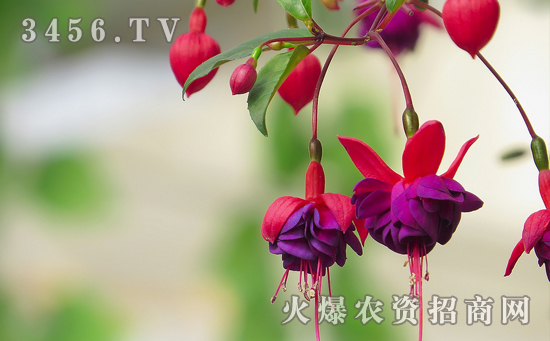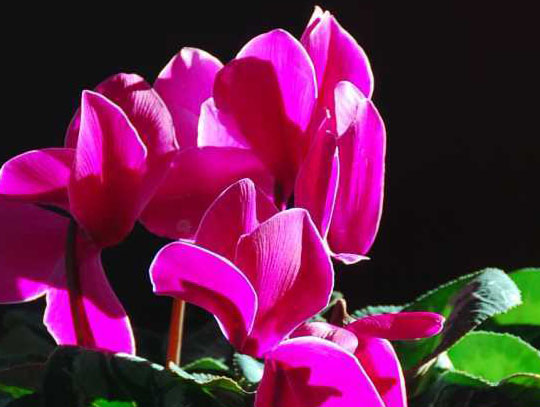Botrytis cinerea
Symptoms and pathological changes: Botrytis cinerea is called leaf mold. The main damage to leaves was from late April to early May, and the peak period was in the early and middle of August. From July to August, there is much rainfall and high humidity, which is beneficial to the spread of diseases. The disease is more serious in the courtyard where the planting is too dense and the cultivation management is poor. After suffering frost injury, the resistance of plants is weak and the disease is serious. There were differences in the degree of disease among varieties. At the beginning of the disease, there were nearly round purple-brown spots on the leaves, which were 1 mm in diameter and 5 mm in diameter, and then expanded into irregular spots, 7 mm in diameter, yellowish in the center, purplish brown on the edge, and obvious concentric patterns on the disease spot. The plaque expands and connects into pieces. Dark green mildew is produced on the surface of the disease spot when it is wet, that is, the conidia and conidia of the pathogen. The disease often occurs in rainy weather or excessive application of nitrogen fertilizer or lack of light. The pathogen overwintered with mycelium on the stump stem and withered leaves of the diseased plant, and the conidia were transmitted by airflow and Rain Water in spring, infecting and harming the lower leaves. The pathogen overwintered with mycelium on the stump stem and withered leaves of the diseased plant, and spores were transmitted by airflow and Rain Water in spring, infecting and harming the lower leaves.
The prevention and control methods of Botrytis cinerea are as follows: 1. Pay attention to ventilation and light transmission. 2. Pay attention to drainage. 3. Cut off and deal with the diseased branches and leaves in time after the disease in order to reduce the source of the disease. 4. In the early stage of the disease, 65% zinc or 50% carbendazim and other new agents with 500 times solution were sprayed every 7 to 10 days for 3 times or 4 times, or 50% methyl topiramate 800 times, once every 10 to 15 days for a total of 3 times.

How to control diseases and pests of Admiralty upside down? pest control methods of hanging Admiralty upside down
The main diseases and insect pests that endanger the upside down Admiralty are:
Botrytis cinerea (Botrytis cinerea) caused by ① upside down: the disease often occurs in overcast and rainy weather or when there is too much nitrogen fertilizer or insufficient light. It mainly harms stems, leaves and flowers, resulting in water-like spots on the affected parts. If it is not prevented in time, the hyphae will gradually expand and be covered with gray hairs, and in serious cases, the plants will die.
Prevention and control of Botrytis cinerea: spraying 65% zinc or 50% carbendazim and other new agents with 500 times solution in time at the initial stage of the disease. Spray once every 7 to 10 days, for 3 times in a row. Usually pay attention to ventilation and light to make the plant grow well and improve the disease resistance of the plant. After the disease, the diseased branches and leaves should be cut off and treated in time to reduce the source of the disease.
② inverted Admiralty powdery mildew: the disease mainly harms stems, leaves and flower buds. After being infected, there is a layer of white powder on the surface, which shrinks the leaves and makes the flowers smaller.
Prevention and control methods of Botrytis cinerea: pay attention to ventilation and light, increase the application of phosphorus and potassium fertilizer, and improve plant disease resistance. After the onset of the disease, spray 70% Tuobu body liquid or 2500 times liquid strychnine or other appropriate agents in time, spray every 10 days, spray 2 times 3 times continuously.
Root rot of ③ hanging upside down: the main cause of the disease is: overwatering in hot summer, resulting in root rot, branches and leaves yellowing, and serious plant death.
Prevention and control of Botrytis cinerea by hanging upside down: irrigate the rhizosphere soil with 50% benzoyl ammonium of 300 times liquid in time after the disease. At the same time, pay attention to ventilation and cooling in summer, and basin soil watering should not be too much.
④ inverted golden bell whitefly: different worms can be seen in the same period, adults, harmful to tender leaves, absorb mesophyll juice; nymphs are fixed on the back of leaves after hatching, prickling harm, so that leaves curl, so that dry. In addition, the honeydew secreted by whitefly can easily cause soot disease after contaminating the leaves.
Prevention and control of Botrytis cinerea by hanging upside down: when insect pests are found, 1000 times of omethoate or 2000 times of liquid will be sprayed in time. Spray once every 7 days, 3 times in a row. Be careful when spraying: both sides of the leaves should be sprayed.
How to control diseases and insect pests of Admiralty upside down? the pest control methods of hanging Admiralty upside down are briefly introduced here. To prevent the occurrence of diseases and insect pests of Admiralty upside down, the most important thing is to understand its growth habits and reasonable cultivation. Hanging the golden bell upside down is suitable for growing in a warm and humid environment, to avoid high temperature and excessive drought. Hanging Admiralty upside down likes a cool, well-ventilated environment, and avoid direct glare in summer. At the same time, it is necessary to keep the soil fertile and ensure adequate nutrients.
- Prev

Leaf spot of eight Immortals
Symptoms and pathological changes: Baxian mosaic spot is mainly distributed in Sichuan, Henan, Guangdong, Taiwan, Jilin, Shanghai, Zhejiang, Hunan and other places. The disease mainly occurs on the leaves, the leaf spot is a light yellowish brown watery spot at first, and then expands into a circle, nearly round, 2mm in diameter.
- Next

How to control cyclamen diseases and insect pests
(1) root knot nematode disease. The nematode invades the root of the seedling and grows many nodules large and small on the main root and lateral root. The nematode sucks the juice in the tumor, causing the fine root to be swollen and rot, and the aboveground part withered. Control method: disinfect the soil before ① planting, stir-fry the soil in an iron pan for 40 minutes.
Related
- Fuxing push coffee new agricultural production and marketing class: lack of small-scale processing plants
- Jujube rice field leisure farm deep ploughing Yilan for five years to create a space for organic food and play
- Nongyu Farm-A trial of organic papaya for brave women with advanced technology
- Four points for attention in the prevention and control of diseases and insect pests of edible fungi
- How to add nutrient solution to Edible Fungi
- Is there any good way to control edible fungus mites?
- Open Inoculation Technology of Edible Fungi
- Is there any clever way to use fertilizer for edible fungus in winter?
- What agents are used to kill the pathogens of edible fungi in the mushroom shed?
- Rapid drying of Edible Fungi

